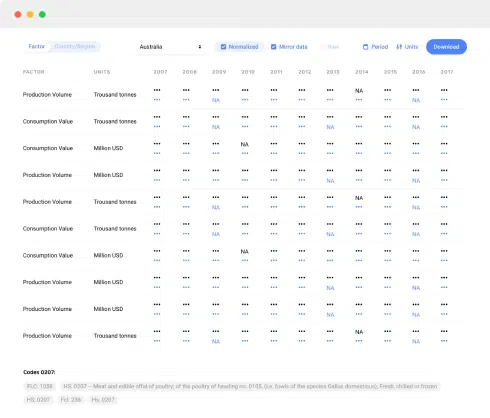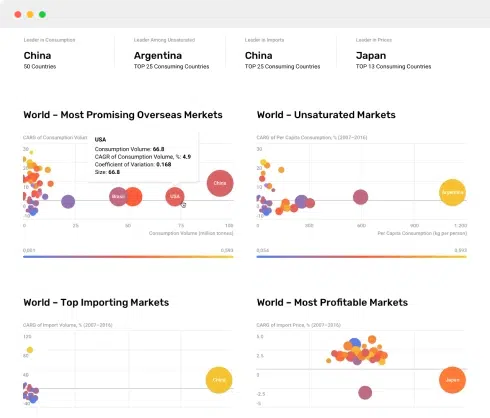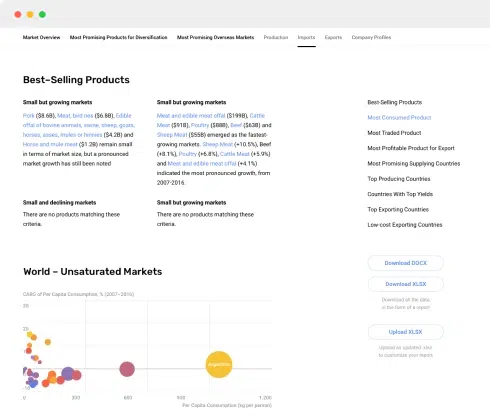
Africa - Polyethylene Glycols and Polyethers in Primary Forms - Market Analysis, Forecast, Size, Trends and Insights
Get instant access to more than 2 million reports, dashboards, and datasets on the IndexBox Platform.
View PricingAfrica: Market for Polyethylene Glycols and Polyethers in Primary Forms 2025
Market Size for Polyethylene Glycols and Polyethers in Primary Forms in Africa
The African polyethylene glycol and polyether market soared to $X in 2021, surging by 36% against the previous year. The market value increased at an average annual rate of +4.5% over the period from 2012 to 2021; however, the trend pattern indicated some noticeable fluctuations being recorded in certain years. As a result, consumption attained the peak level and is likely to continue growth in the immediate term.
Production of Polyethylene Glycols and Polyethers in Primary Forms in Africa
In value terms, polyethylene glycol and polyether production fell to $X in 2021 estimated in export price. The total production indicated notable growth from 2012 to 2021: its value increased at an average annual rate of +3.9% over the last nine years. The trend pattern, however, indicated some noticeable fluctuations being recorded throughout the analyzed period. Based on 2021 figures, production increased by +53.1% against 2013 indices. The pace of growth was the most pronounced in 2018 when the production volume increased by 11%. Over the period under review, production attained the peak level at $X in 2020, and then declined in the following year.
Exports of Polyethylene Glycols and Polyethers in Primary Forms
Exports in Africa
In 2021, approx. X tons of polyethylene glycols and polyethers in primary forms were exported in Africa; picking up by 16% against 2020 figures. In general, exports saw strong growth. The pace of growth was the most pronounced in 2017 when exports increased by 92%. Over the period under review, the exports hit record highs in 2021 and are likely to see steady growth in years to come.
In value terms, polyethylene glycol and polyether exports skyrocketed to $X in 2021. Overall, exports continue to indicate a tangible increase. The growth pace was the most rapid in 2017 when exports increased by 94%. The level of export peaked in 2021 and is likely to continue growth in the near future.
Exports by Country
Morocco (X tons), Egypt (X tons), Tanzania (X tons) and South Africa (X tons) represented roughly 95% of total exports in 2021. Uganda (X tons) held a minor share of total exports.
From 2012 to 2021, the most notable rate of growth in terms of shipments, amongst the key exporting countries, was attained by Tanzania (with a CAGR of +52.8%), while the other leaders experienced more modest paces of growth.
In value terms, Egypt ($X), Morocco ($X) and South Africa ($X) constituted the countries with the highest levels of exports in 2021, with a combined 87% share of total exports. These countries were followed by Tanzania and Uganda, which together accounted for a further 11%.
Tanzania, with a CAGR of +31.2%, saw the highest rates of growth with regard to the value of exports, among the main exporting countries over the period under review, while shipments for the other leaders experienced more modest paces of growth.
Export Prices by Country
In 2021, the export price in Africa amounted to $X per ton, increasing by 25% against the previous year. Overall, the export price, however, showed a pronounced reduction. Over the period under review, the export prices attained the peak figure at $X per ton in 2014; however, from 2015 to 2021, the export prices stood at a somewhat lower figure.
Prices varied noticeably by country of origin: amid the top suppliers, the country with the highest price was Egypt ($X per ton), while Tanzania ($X per ton) was amongst the lowest.
From 2012 to 2021, the most notable rate of growth in terms of prices was attained by Egypt (+1.7%), while the other leaders experienced a decline in the export price figures.
Imports of Polyethylene Glycols and Polyethers in Primary Forms
Imports in Africa
Polyethylene glycol and polyether imports expanded remarkably to X tons in 2021, growing by 8.8% compared with 2020. The total import volume increased at an average annual rate of +4.2% over the period from 2012 to 2021; however, the trend pattern indicated some noticeable fluctuations being recorded throughout the analyzed period. The most prominent rate of growth was recorded in 2018 with an increase of 17% against the previous year. Over the period under review, imports attained the peak figure in 2021 and are likely to see steady growth in the immediate term.
In value terms, polyethylene glycol and polyether imports surged to $X in 2021. Total imports indicated resilient growth from 2012 to 2021: its value increased at an average annual rate of +5.0% over the last nine-year period. The trend pattern, however, indicated some noticeable fluctuations being recorded throughout the analyzed period. As a result, imports reached the peak and are likely to continue growth in the immediate term.
Imports by Country
The countries with the highest levels of polyethylene glycol and polyether imports in 2021 were Nigeria (X tons), Egypt (X tons), South Africa (X tons), Algeria (X tons), Morocco (X tons), Ethiopia (X tons), Kenya (X tons), Tanzania (X tons), Libya (X tons), Ghana (X tons), Cote d'Ivoire (X tons) and Tunisia (X tons), together resulting at 82% of total import.
From 2012 to 2021, the biggest increases were recorded for Ethiopia (with a CAGR of +22.1%), while purchases for the other leaders experienced more modest paces of growth.
In value terms, the largest polyethylene glycol and polyether importing markets in Africa were Egypt ($X), Nigeria ($X) and South Africa ($X), with a combined 38% share of total imports. These countries were followed by Algeria, Morocco, Ethiopia, Kenya, Tanzania, Ghana, Libya, Tunisia and Cote d'Ivoire, which together accounted for a further 44%.
In terms of the main importing countries, Ethiopia, with a CAGR of +21.2%, recorded the highest rates of growth with regard to the value of imports, over the period under review, while purchases for the other leaders experienced more modest paces of growth.
Import Prices by Country
The import price in Africa stood at $X per ton in 2021, surging by 51% against the previous year. In general, the import price saw a relatively flat trend pattern. As a result, import price attained the peak level and is likely to continue growth in the immediate term.
Average prices varied somewhat amongst the major importing countries. In 2021, major importing countries recorded the following prices: in Egypt ($X per ton) and Morocco ($X per ton), while Cote d'Ivoire ($X per ton) and Ethiopia ($X per ton) were amongst the lowest.
From 2012 to 2021, the most notable rate of growth in terms of prices was attained by Kenya (+2.3%), while the other leaders experienced more modest paces of growth.
Source: IndexBox Platform
Frequently Asked Questions (FAQ) :
This report provides an in-depth analysis of the market for polyethylene glycol and polyether in Africa. Within it, you will discover the latest data on market trends and opportunities by country, consumption, production and price developments, as well as the global trade (imports and exports). The forecast exhibits the market prospects through 2030.
Product coverage:
- Prodcom 20164015 - Polyethylene glycols and other polyether alcohols, in primary forms
- Prodcom 20164020 - Polyethers, in primary forms (excluding polyacetals, polyether alcohols)
Country coverage:
- Algeria
- Angola
- Benin
- Botswana
- Burkina Faso
- Burundi
- Cabo Verde
- Cameroon
- Central African Republic
- Chad
- Comoros
- Congo
- Democratic Republic of the Congo
- Djibouti
- Egypt
- Equatorial Guinea
- Eritrea
- Ethiopia
- Gabon
- Gambia
- Ghana
- Guinea
- Guinea-Bissau
- Kenya
- Lesotho
- Liberia
- Libya
- Madagascar
- Malawi
- Mali
- Mauritania
- Mauritius
- Mayotte
- Morocco
- Mozambique
- Namibia
- Niger
- Nigeria
- Reunion
- Rwanda
- Saint Helena, Ascension and Tristan da Cunha
- Sao Tome and Principe
- Senegal
- Seychelles
- Sierra Leone
- Somalia
- South Africa
- Sudan
- Swaziland
- Tanzania
- Togo
- Tunisia
- Uganda
- Zambia
- Zimbabwe
- Cote d'Ivoire
- Western Sahara
- South Sudan
Data coverage:
- Market volume and value
- Per Capita consumption
- Forecast of the market dynamics in the medium term
- Production in Africa, split by region and country
- Trade (exports and imports) in Africa
- Export and import prices
- Market trends, drivers and restraints
- Key market players and their profiles
Reasons to buy this report:
- Take advantage of the latest data
- Find deeper insights into current market developments
- Discover vital success factors affecting the market
This report is designed for manufacturers, distributors, importers, and wholesalers, as well as for investors, consultants and advisors.
In this report, you can find information that helps you to make informed decisions on the following issues:
- How to diversify your business and benefit from new market opportunities
- How to load your idle production capacity
- How to boost your sales on overseas markets
- How to increase your profit margins
- How to make your supply chain more sustainable
- How to reduce your production and supply chain costs
- How to outsource production to other countries
- How to prepare your business for global expansion
While doing this research, we combine the accumulated expertise of our analysts and the capabilities of artificial intelligence. The AI-based platform, developed by our data scientists, constitutes the key working tool for business analysts, empowering them to discover deep insights and ideas from the marketing data.
1. INTRODUCTION
Making Data-Driven Decisions to Grow Your Business
- REPORT DESCRIPTION
- RESEARCH METHODOLOGY AND THE AI PLATFORM
- DATA-DRIVEN DECISIONS FOR YOUR BUSINESS
- GLOSSARY AND SPECIFIC TERMS
2. EXECUTIVE SUMMARY
A Quick Overview of Market Performance
- KEY FINDINGS
- MARKET TRENDS This Chapter is Available Only for the Professional EditionPRO
3. MARKET OVERVIEW
Understanding the Current State of The Market and its Prospects
- MARKET SIZE: HISTORICAL DATA (2012–2024) AND FORECAST (2025–2035)
- CONSUMPTION BY COUNTRY: HISTORICAL DATA (2012–2024) AND FORECAST (2025–2035)
- MARKET FORECAST TO 2035
4. MOST PROMISING PRODUCTS FOR DIVERSIFICATION
Finding New Products to Diversify Your Business
- TOP PRODUCTS TO DIVERSIFY YOUR BUSINESS
- BEST-SELLING PRODUCTS
- MOST CONSUMED PRODUCTS
- MOST TRADED PRODUCTS
- MOST PROFITABLE PRODUCTS FOR EXPORT
5. MOST PROMISING SUPPLYING COUNTRIES
Choosing the Best Countries to Establish Your Sustainable Supply Chain
- TOP COUNTRIES TO SOURCE YOUR PRODUCT
- TOP PRODUCING COUNTRIES
- TOP EXPORTING COUNTRIES
- LOW-COST EXPORTING COUNTRIES
6. MOST PROMISING OVERSEAS MARKETS
Choosing the Best Countries to Boost Your Export
- TOP OVERSEAS MARKETS FOR EXPORTING YOUR PRODUCT
- TOP CONSUMING MARKETS
- UNSATURATED MARKETS
- TOP IMPORTING MARKETS
- MOST PROFITABLE MARKETS
7. PRODUCTION
The Latest Trends and Insights into The Industry
- PRODUCTION VOLUME AND VALUE: HISTORICAL DATA (2012–2024) AND FORECAST (2025–2035)
- PRODUCTION BY COUNTRY: HISTORICAL DATA (2012–2024) AND FORECAST (2025–2035)
8. IMPORTS
The Largest Import Supplying Countries
- IMPORTS: HISTORICAL DATA (2012–2024) AND FORECAST (2025–2035)
- IMPORTS BY COUNTRY: HISTORICAL DATA (2012–2024) AND FORECAST (2025–2035)
- IMPORT PRICES BY COUNTRY: HISTORICAL DATA (2012–2024) AND FORECAST (2025–2035)
9. EXPORTS
The Largest Destinations for Exports
- EXPORTS: HISTORICAL DATA (2012–2024) AND FORECAST (2025–2035)
- EXPORTS BY COUNTRY: HISTORICAL DATA (2012–2024) AND FORECAST (2025–2035)
- EXPORT PRICES BY COUNTRY: HISTORICAL DATA (2012–2024) AND FORECAST (2025–2035)
10. PROFILES OF MAJOR PRODUCERS
The Largest Producers on The Market and Their Profiles
-
11. COUNTRY PROFILES
The Largest Markets And Their Profiles
This Chapter is Available Only for the Professional Edition PRO- Algeria
- Angola
- Benin
- Botswana
- Burkina Faso
- Burundi
- Cabo Verde
- Cameroon
- Central African Republic
- Chad
- Comoros
- Congo
- Democratic Republic of the Congo
- Djibouti
- Egypt
- Equatorial Guinea
- Eritrea
- Ethiopia
- Gabon
- Gambia
- Ghana
- Guinea
- Guinea-Bissau
- Kenya
- Lesotho
- Liberia
- Libya
- Madagascar
- Malawi
- Mali
- Mauritania
- Mauritius
- Mayotte
- Morocco
- Mozambique
- Namibia
- Niger
- Nigeria
- Reunion
- Rwanda
- Saint Helena, Ascension and Tristan da Cunha
- Sao Tome and Principe
- Senegal
- Seychelles
- Sierra Leone
- Somalia
- South Africa
- Sudan
- Swaziland
- Tanzania
- Togo
- Tunisia
- Uganda
- Zambia
- Zimbabwe
- Cote d'Ivoire
- Western Sahara
- South Sudan
LIST OF TABLES
- Key Findings In 2024
- Market Volume, In Physical Terms: Historical Data (2012–2024) and Forecast (2025–2035)
- Market Value: Historical Data (2012–2024) and Forecast (2025–2035)
- Per Capita Consumption, by Country, 2022–2024
- Production, In Physical Terms, By Country: Historical Data (2012–2024) and Forecast (2025–2035)
- Imports, In Physical Terms, By Country: Historical Data (2012–2024) and Forecast (2025–2035)
- Imports, In Value Terms, By Country: Historical Data (2012–2024) and Forecast (2025–2035)
- Import Prices, By Country: Historical Data (2012–2024) and Forecast (2025–2035)
- Exports, In Physical Terms, By Country: Historical Data (2012–2024) and Forecast (2025–2035)
- Exports, In Value Terms, By Country: Historical Data (2012–2024) and Forecast (2025–2035)
- Export Prices, By Country: Historical Data (2012–2024) and Forecast (2025–2035)
LIST OF FIGURES
- Market Volume, In Physical Terms: Historical Data (2012–2024) and Forecast (2025–2035)
- Market Value: Historical Data (2012–2024) and Forecast (2025–2035)
- Consumption, by Country, 2024
- Market Volume Forecast to 2035
- Market Value Forecast to 2035
- Market Size and Growth, By Product
- Average Per Capita Consumption, By Product
- Exports and Growth, By Product
- Export Prices and Growth, By Product
- Production Volume and Growth
- Exports and Growth
- Export Prices and Growth
- Market Size and Growth
- Per Capita Consumption
- Imports and Growth
- Import Prices
- Production, In Physical Terms: Historical Data (2012–2024) and Forecast (2025–2035)
- Production, In Value Terms: Historical Data (2012–2024) and Forecast (2025–2035)
- Production, by Country, 2024
- Production, In Physical Terms, by Country: Historical Data (2012–2024) and Forecast (2025–2035)
- Imports, In Physical Terms: Historical Data (2012–2024) and Forecast (2025–2035)
- Imports, In Value Terms: Historical Data (2012–2024) and Forecast (2025–2035)
- Imports, In Physical Terms, By Country, 2024
- Imports, In Physical Terms, By Country: Historical Data (2012–2024) and Forecast (2025–2035)
- Imports, In Value Terms, By Country: Historical Data (2012–2024) and Forecast (2025–2035)
- Import Prices, By Country: Historical Data (2012–2024) and Forecast (2025–2035)
- Exports, In Physical Terms: Historical Data (2012–2024) and Forecast (2025–2035)
- Exports, In Value Terms: Historical Data (2012–2024) and Forecast (2025–2035)
- Exports, In Physical Terms, By Country, 2024
- Exports, In Physical Terms, By Country: Historical Data (2012–2024) and Forecast (2025–2035)
- Exports, In Value Terms, By Country: Historical Data (2012–2024) and Forecast (2025–2035)
- Export Prices, By Country: Historical Data (2012–2024) and Forecast (2025–2035)
Recommended reports
This report provides an in-depth analysis of the market for polyethylene glycol and polyether in Asia.
This report provides an in-depth analysis of the global market for polyethylene glycol and polyether.
This report provides an in-depth analysis of the market for polyethylene glycol and polyether in the EU.
This report provides an in-depth analysis of the market for polyethylene glycol and polyether in the U.S..
This report provides an in-depth analysis of the market for polyethylene glycol and polyether in China.
- Polyether Alcohols Market
- Synthetic Latex Rubber Market
- Soap in Different Forms Market
- Non-soap Washing and Cleaning Preparations Market
- Explosives Market
- Lubricating Oil Additive Market
- Anti-freezing Preparations Market
- Polyethylene in Primary Forms Market
- Polypropylene in Primary Forms Market
- Polystyrene in Primary Forms Market


